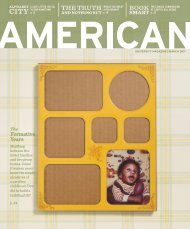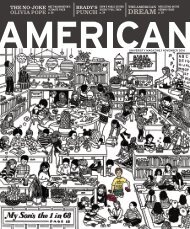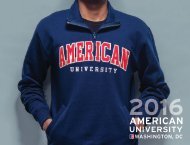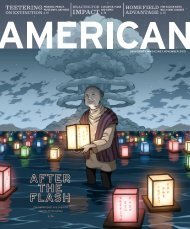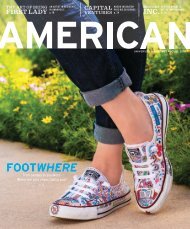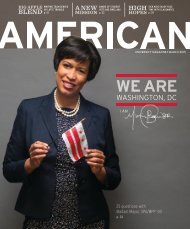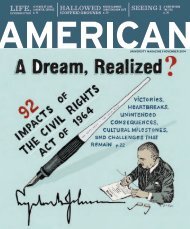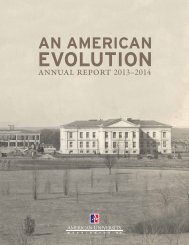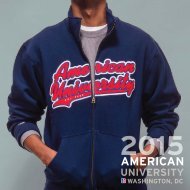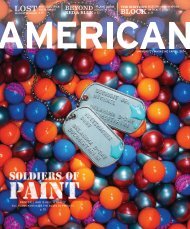American Magazine: August 2014
You also want an ePaper? Increase the reach of your titles
YUMPU automatically turns print PDFs into web optimized ePapers that Google loves.
international<br />
AU ALUMNI CURRENTLY<br />
IN PEACE CORPS SERVICE<br />
PRODUCER OF PEACE CORPS<br />
VOLUNTEERS AMONG<br />
MEDIUM-SIZE SCHOOLS<br />
AU VOLUNTEERS IN MORE<br />
THAN 100 COUNTRIES<br />
SINCE 1961 (SEE MAP)<br />
OVERALL FOR MASTER’S<br />
INTERNATIONAL (NO. 10) AND<br />
COVERDELL FELLOWS (NO. 9)<br />
PROGRAMS<br />
MEG FOWLER ’12 KNEW<br />
SHE WANTED TO JOIN THE<br />
PEACE CORPS after graduating<br />
with a dual major in international<br />
studies and economics. She packed<br />
off for Morocco, where she teaches<br />
high school students how to succeed<br />
in business, plant a community<br />
garden, and speak English.<br />
Ukraine volunteer Shelby Lane<br />
taught English, launched a<br />
newspaper for young readers, and<br />
ran workshops on topics from HIV/AIDS<br />
awareness to the environment. That<br />
experience and a Coverdell fellowship<br />
led her to AU to pursue dual master’s<br />
degrees in international peace and<br />
conflict resolution and secondary<br />
education while leading the AU Peace<br />
Corps Community and Creative Peace<br />
Initiatives and volunteering with Little<br />
Friends for Peace.<br />
What do they have in common? An<br />
urge to serve and an AU connection.<br />
AU and the Peace Corps go back,<br />
all the way to 1961, when the first<br />
groups of volunteers took off for<br />
postings in places like Pakistan and<br />
the Philippines. Back in the day the<br />
connection was simple and straight on:<br />
You go to college. You graduate. You<br />
join the Peace Corps.<br />
Bringing It Home<br />
Today, says Stephen Angelsmith,<br />
director of Peace Corps programs at<br />
AU’s School of International Service,<br />
the partnership has many moving<br />
parts, keeping students engaged in<br />
a cycle of service made possible by<br />
two Peace Corps–associated graduate<br />
programs: the Master’s International<br />
(MI) and the Paul D. Coverdell Fellows.<br />
MI students spend a year in the<br />
classroom and two years in the Peace<br />
Corps, for credit, after which they<br />
return to campus to complete their<br />
graduate work. Coverdell fellows—<br />
all returned Peace Corps volunteers<br />
(RPCVs)—receive scholarships for<br />
graduate studies that include an<br />
internship in an underserved U.S.<br />
community, an opportunity to teach<br />
<strong>American</strong>s about the world beyond<br />
our borders.<br />
RPCVs may donate memorabilia to<br />
the Peace Corps Community Archive,<br />
a repository of living history curated<br />
by the AU library.<br />
“I’ve realized how important it is to<br />
be a role model,” says Lane. “I believe<br />
in and enjoy service, and have seen<br />
the power it has to inspire change.”<br />
8 AMERICAN MAGAZINE AUGUST <strong>2014</strong>





